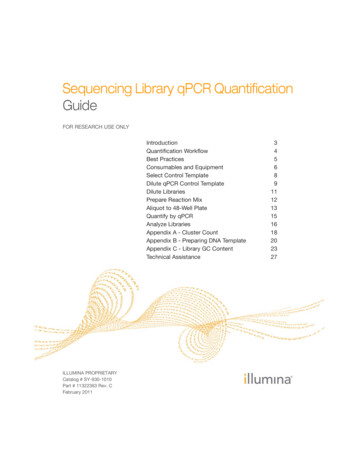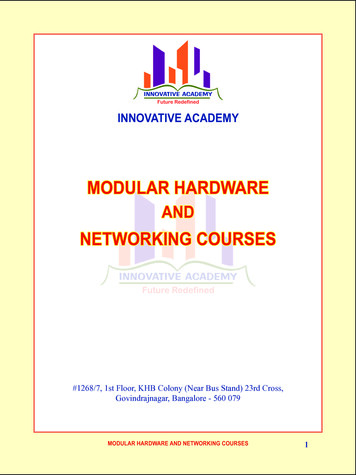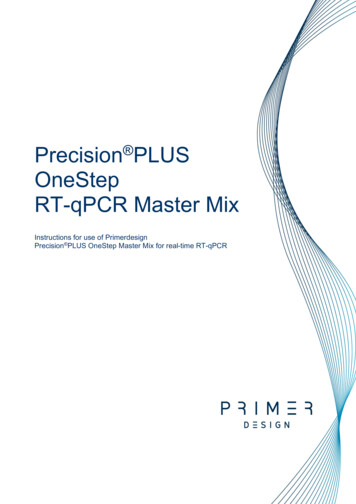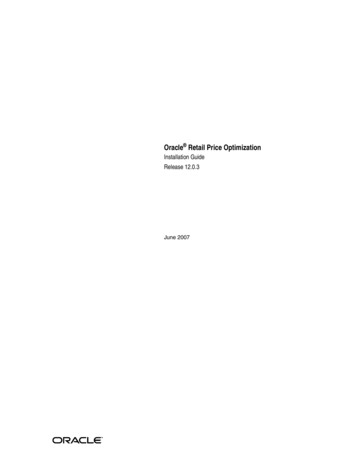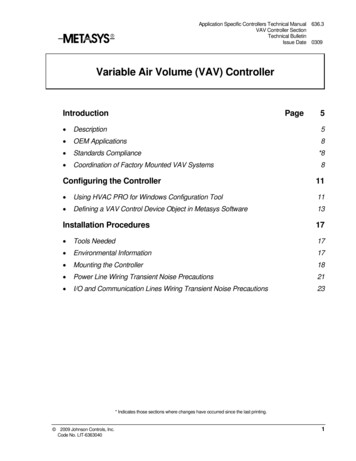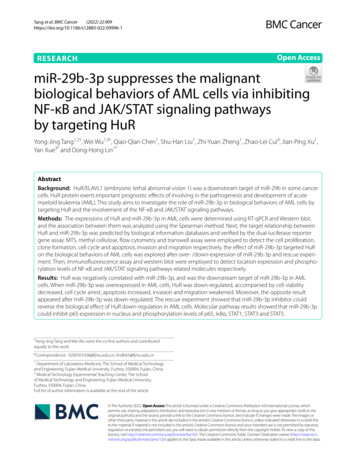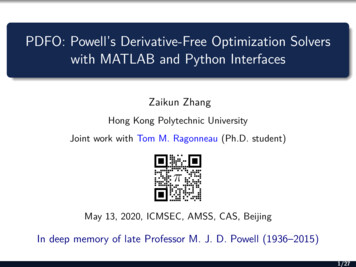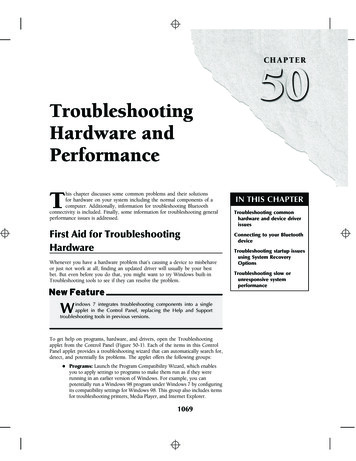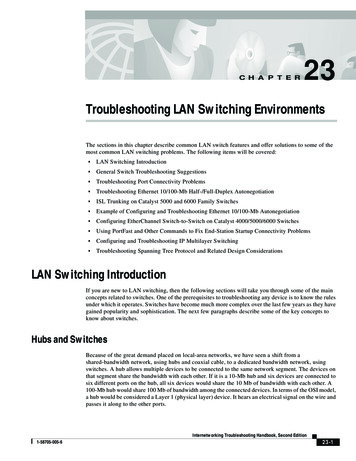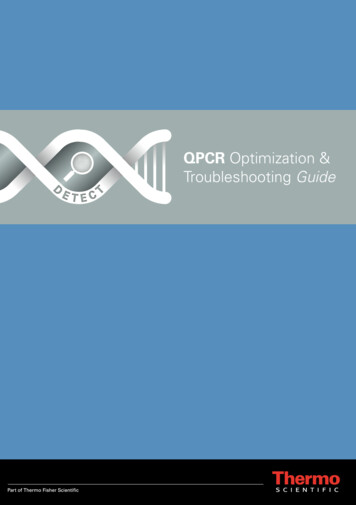
Transcription
DETECTQPCR Optimization &Troubleshooting Guide
IntroductionWhether you are beginning to develop a QPCR assay, have aQPCR assay you want to optimize, or are getting questionableresults and don’t know why, this guide is for you.Simply bringing together all the necessary components for QPCRis often not enough to obtain accurate and consistent results.Following a protocol that instructs you how to combine yourtemplate with reagents before running them on your choseninstrument only covers the basics of real-time PCR. The science ofreal-time PCR comes from understanding how the nuances of thistechnique affect your results.This quick reference guide is intended to educate you to gain abetter understanding of these finer details, empowering you tooptimize or troubleshoot your assay in order to achieve the bestresults possible on a consistent basis. It captures the knowledgethat we have accumulated over 20 years manufacturing andoptimizing PCR reagents and plastics for the life science industry.D02ETECT
Optimization GuideRefer to this table before you begin your QPCR assay.Use the information to ensure that you plan your protocol using best practice methodologies.OPTIMIZATION PARAMETERRECOMMENDATIONQPCR PlateIt is recommended that opaque white PCR plates are used for QPCR analysis. The whitecolor virtually eliminates cross talk and improves the efficiency of fluorescent detectionthereby increasing assay sensitivity and well-to-well consistency.Template QualityIt is essential that the nucleic acid is sufficiently pure for QPCR analysis. Templatecontamination (ie. genomic DNA, protein, carbohydrates or organic solvents) can have ahuge impact on assay reliability and reproducibility. Template quality should be determinedby spectrophotometry (ie. Nanodrop), microfluidics or PAGE.Amplicon SizeIdeally, the amplicon should always be between 100bp and 150bp to ensure the QPCRreaction efficiency is as close to 100% as possible. Good QPCR efficiency promotes assayreproducibility and sensitivity.Primer DesignGiven that PCR primers are a relatively cheap component of a QPCR assay, it is goodpractice to order and test at least 2 primer pairs for every new QPCR assay. This willmaximize the chance of establishing a reliable, reproducible and sensitive assay.Test PrimersMeasure the reproducibility, specificity, sensitivity and dynamic range of your QPCR assayusing SYBR Green chemistry across a template dilution series. Ideally, the efficiency of theQPCR reaction should be at least 90% and below 105%, while the assay reproducibilityshould be higher then r 0.998.Efficient RTInitially, the RT step should be performed as specified in the supplier protocol. However, thelength and the temperature of the RT step can be optimized to increase the efficiency ofthe reverse transcriptase. The reverse transcriptase should be tested across a range of RNAconcentrations to ensure assay linearity.Hot-StartStandard Thermo Scientific QPCR master mixes require a 15 minute heating step at 95oCto ensure the hot-start Taq is fully activated. This step cannot be shortened under anycircumstances. A shorter heating step will impact assay reproducibility and sensitivity.Thermal ProtocolEven if your assay has been optimized using an alternative supplier’s mix, once the ThermoStart mix is used it is advisible to start using the protocol recommended in the ThermoScientific QPCR master mix. If assay optimization is required, the annealing temperatureshould be examined first.Annealing TemperatureTest a range of annealing temperatures. Depending on the QPCR results, the annealingtemperature should be increased or decreased in 2-3oC increments. This can be done in asingle experiment using a thermal gradient. Alternatively, a range of annealing temperaturesshould be tested using multiple QPCR experiments.Primer ConcentrationAlways start by using the primer concentration recommended in the master mix protocol.If optimization is required, try stepping the primer concentration up and down in 25mMincrements. Optimizing primer concentration using a titration matrix can give improvedresults in rare circumstances but this is time-consuming.03
Troubleshooting GuideRefer to this table if you have performed a QPCR assay that resulted in sub-optimal results.Use this information to tweak the components, conditions, and reaction parameters in order toovercome erroneous results.04PROBLEMPOSSIBLE CAUSESACTIONS (Based on Thermo Scientific QPCR Master Mix Protocol)No amplification orvery high CtEnzyme not fullyactivatedEnsure the initial 95ºC activation step is carried out for the full 15 minutes (or 10minutes in the Fast Protocol).Poor primer designCheck the PCR product by melt curve analysis or on an agarose gel. It is good practiceto try at least 2 primer pairs.RT step too shortExtend the RT step in 5 minute increments up to 60 minutes.RT temperaturetoo lowIncrease RT reaction temperature in 5ºC increments up to 57ºC.Annealing step tooshortIncrease annealing step in 3s increments up to 30s.Annealingtemperature too highDecrease the annealing temperature in 2ºC increments.Extension time tooshortIncrease the extension time in 5s increments, up to 30s for amplicons of up to 500bp.Amplicon too longAmplicons should ideally be 100-150bp long and should not exceed 500bp.Poor template qualityCheck the quality of the template preparation using spectrophotometry, microfluidicsor PAGE.Insufficient templateIncrease amount of template to ensure enough copies of target included.Template containsinhibitorsPurify template or repeat the assay using a 1:10 or a 1:100 dilution of the template.Insufficient cyclesIncrease the number of PCR cycles to 40.Wrong dye/channelsusedCheck machine settings correspond with the intercalating dye (eg. SYBR Green) or thedye conjugated to the fluorescent probe and that the ROX / fluorescein levels are correct.Error in setupCheck concentrations and storage conditions of the reaction components and thenrepeat the reaction.Reactioncomponents notmixed thoroughlyRepeat assay ensuring serial dilutions are vortexed for at least 15s and that thereaction components are mixed together thoroughly.Primers degradedCheck the integrity of the PCR primers by denaturing polyacrylamide gelelectrophoresis.Primer concentrationnot optimalStart with primer concentration recommended in protocol and increase in 25mMincrements if necessary.Fluorescent datacollected at wrongstepEnsure fluorescent data is collected at the appropriate step and in the correct channel.Fluorescent reporternot being releasedfrom probeValidate performance of PCR primers using SYBR Green. Redesign probe or optimizeprobe binding step if primers are performing well.Probe exposedto light and beenbleachedOnce reaction set up is complete return your probe to the product packaging as soonas possible to mimimize exposure to light.
Troubleshooting GuidePROBLEMPOSSIBLE CAUSESACTIONS (Based on Thermo Scientific QPCR Master Mix Protocol)Non-specificamplification and /or primer-dimersAnnealingtemperature too lowIncrease annealing temperature in 2ºC increments - use a thermal gradient if possible.Poor primer designRe-design primers using Primer3 or another QPCR primer design tool. It is goodpractice to try at least 2 primer pairs.RNA templatecontaminated withgenomic DNARemove genomic DNA from RNA template with DNase I or use RT Enhancer withVerso QRT-PCR kits. Design primers to span exon-exon boundaries.RT reaction setup atroom temperatureSetup the RT reactions on ice and transfer the RT reactions from ice to the reactionblock, starting the RT protocol immediately.Primers degradedCheck the integrity of the PCR primers by denaturing polyacrylamide gelelectrophoresis.ReagentscontaminatedDiscard reagents and repeat assay with fresh reaction components.Contaminationoccurred duringreaction setupUse barrier tips, screw-cap tubes and setup QPCR reaction in a DNA-free zone beforeadding the template in a separate location.Fluorescence in 'noRT control'RNA templatecontaminated withgenomic DNARemove genomic DNA from RNA template with DNase I or use RT Enhancer withVerso QRT-PCR kits. Design primers to span exon-exon boundaries.Poor linearity ofCt values acrossdilution series (Rvalue 0.998)Too much nucleicacid in 'high copynumber' assaysUse less than 500ng of template in each QPCR or QRT-PCR reaction.Too little nucleic acidpresent in 'low copynumber' assaysIncrease the amount of template or increase PCR reaction efficiency by optimizingthermal protocol / re-designing primers.Annealingtemperature too lowIncrease the annealing temperature in 2ºC increments - use a thermal gradient ifpossible.Reactioncomponents notmixed thoroughlyRepeat assay ensuring all serial dilutions are vortexed for 15s and reaction componentsare mixed properlyPoor template qualityCheck the quality of the template preparation using spectrophotometry, microfluidicsor PAGE.Primer-dimers boundto SYBR GreenOptimize thermal protocol ie. increase the annealing temperature in 2ºC increments use a thermal gradient if possible.Serial dilutions notcalculated properlyRepeat serial dilution using fresh sample material and calculate concentrationsaccurately.Reaction notreproducibleImprove reproducibility by improving technique / optimizing thermal protocol / redesigning primers.Fluorescence inthe 'no templatecontrol' (NTC)PCR efficiency istoo high ( 105%)05
Troubleshooting Guide06PROBLEMPOSSIBLE CAUSESACTIONS (Based on Thermo Scientific QPCR Master Mix Protocol)PCR efficiency istoo low ( 90%)Poor primer designRe-design primers using primer design software. It is good practice to try at least 2primer pairs.Annealing step tooshortIncrease annealing step in 3s increments up to 30s.Annealingtemperature too highDecrease the annealing temperature in 2ºC increments.Extension time tooshortIncrease the extension time in 5s increments, up to 30s for amplicons of up to 500bp.Template containsinhibitorsPurify template or use different template extraction method and repeat the assay.Serial dilutions notcalculated properlyRepeat serial dilution using fresh sample material and calculate concentrationsaccurately.Amplicon too longAmplicon should ideally be 100-150bp long and should not exceed 500bp.Fluorescent signalclimbs and thenfalls sharplyFluorescenceincreased so rapidlythat baselinecorrection tiltedcurve forwardsAdjust baseline correction (ie from cycles 3-15 to 3-10 or dilute template between1:100 and 1:1000 and repeat).Amplification plotgoes up, down andall aroundBaseline hasbeen set so whensoftware applies datacorrection curves aredistortedAdjust baseline correction (ie from cycles 3-15 to 3-10 or dilute template between1:100 and 1:1000 and repeat).Amplification plotdoesn’t reachthresholdBaselinefluorescence isvery high in 'hightemplate' reactionsManually adjust threshold so it crosses log-linear phase of each amplification plot ordilute template between 1:100 and 1:1000 and repeat.Amplification plotnot exponentialTemplate containsinhibitorsPurify template or repeat assay using a 1:10 or a 1:100 dilution of template.Data plots are veryjaggedData being collectedat lowest detectionlimits of cyclerSmooth data by applying a moving average data correction algorithm or re-designassay.
Innovative QPCR SolutionsRefer to our table of products for a start-to-finish solution of reagents, plates, and sealsdesigned specifically to optimize QPCR results.This system of products can dramatically improve the quality and reliability of your QPCR data.ABI7000/73007700/790075007900 FASTStepOne7500 FAST Opticon 2Mx3000PRealplexOpticon480Chromo4Mx3005PQPCR PlasticsThermo Scientific ABgene White QPCR Plates, 25 Plates (50 Plates with 384-well)96-Well AB2400W AB2400W AB1900W AB1900W AB1900W AB1900W AB2400W AB2400W -AB1502WThermo Scientific EasyStrip Snap White QPCR Strip Tubes, 250 Strips with Attached QPCR Caps8-Strip AB1502W AB1502W----AB1502W AB1502W AB1502W AB1502W AB1502WQPCR ReagentsThermo Scientific ABsolute Blue QPCR Master Mixes, 400 x 25uL (1 x 5mL)Probe AB4139AAB4319AAB4139AAB4319A AB4319AAB4319AAB4137A AB4137A AB4137A AB4137A AB4137A AB4137AAB4137ASYBR Green AB4163AAB4323AAB4163AAB4323A AB4323AAB4323AAB4220A AB4167A AB4167A AB4167A AB4167A AB4167AAB4167AThermo Scientific ABsolute Blue Fast QPCR Master Mixes, 400 x 25uL (1 x 5mL)Probe AB4328AAB4330AAB4328AAB4330A AB4328AAB4330AAB4326A AB4326A AB4326A AB4326A AB4326A AB4326AAB4326AQRT-PCR ReagentsThermo Scientific Verso 1-Step QRT-PCR Mixes, 200 x 25uL (2 x 1.25mL)Probe AB4101AAB4102AAB4101AAB4102A AB4102AAB4102AAB4100A AB4100A AB4100A AB4100A AB4100A AB4100AAB4100ASYBR Green AB4105AAB4106AAB4105AAB4106A AB4106AAB4106AAB4107A AB4104A AB4104A AB4104A AB4104A AB4104AAB4104AThermo Scientific Verso 2-Step QRT-PCR Kits, 200 x 25uL (2 x 1.25mL)Probe AB4110AAB4117AAB4110AAB4117A AB4117AAB4117AAB4109A AB4109A AB4109A AB4109A AB4109A AB4109AAB4109ASYBR Green AB4113AAB4116AAB4113AAB4116A AB4116AAB4116AAB4114A AB4112A AB4112A AB4112A AB4112A AB4112AAB4112AQPCR Plate SealThermo Scientific ABsolute QPCR Seal Ultra-Clear Adhesive Plate Seal, 50 SheetsAB-1170 (Compatible with all PCR plates) Free Applicator AB-1391Larger pack sizes available. Please enquire.Need help? Contact your local technical support teamUnited States(800) 235-9880, option #4abgeneus.techservice@thermofisher.comUnited Kingdom01372 840 410abgene.techsupport@thermofisher.comFrance01 60 92 48 68abgene.techsupport@thermofisher.comGermany040 23 51 36 79abgene.techsupport@thermofisher.comRest of the World 44 1372 840 410abgene.techsupport@thermofisher.com07
DETECTHow to orderUnited StatesDirect: (PCR Reagents Only)Fisher Scientific: (All Products)Telephone(800) 874-3723Telephone(800) 766-7000To fax an order(800) 842-5007To fax an order(800) 926-1166Order online: www.thermo.com/abgeneOrder online: www.fishersci.comUnited KingdomDirect: (All Products)Telephone01372 723456To fax an order01372 741414Order online: www.thermo.com/abgeneFranceDirect: (PCR Reagents Only)Dominique Dutscher: (All Products)Fisher Scientific: (All Products)Telephone01 60 92 48 00Telephone03 88 59 33 90Telephone03 88 67 53 23To fax an order01 60 92 49 00To fax an order03 88 59 33 99To fax an order03 88 67 85 11Order online: www.thermo.com/abgeneOrder online: www.dutscher.comOrder online: www.fr.fishersci.comGermanyDirect: (All Products)Telephone040 23 00 21To fax an order040 23 00 55Order online: www.thermo.com/abgeneRest of WorldPlease refer to our Distributors’ list by visiting www.thermo.com/PCRcontact 2009 Thermo Fisher Scientific Inc. All rights reserved. Trademarks are the property of their respective owners. All other trademarks are the property of Thermo Fisher Scientific Inc. and its subsidiaries. Purchase of this product includes an immunityfrom suit under patents specified in the product insert to use only the amount purchased for the purchaser’s own internal research. No other patent rights are conveyed expressly, by implication, or by estoppel. Further informationon purchasing licenses may be obtained by contacting the Director of Licensing, Applied Biosystems, 850 Lincoln Centre Drive, Foster City, California 94404, USA. Practice of the patented 5’ Nuclease Process requires a license fromApplied Biosystems. The purchase of this product includes an immunity from suit under patents specified in the product insert to use only the amount purchased for the purchaser’s own internal research when used with the separatepurchase of Licensed Probe. No other patent rights are conveyed expressly, by implication, or by estoppel. Further information on purchasing licenses may be obtained from the Director of Licensing, Applied Biosystems, 850 LincolnCentre Drive, Foster City, California 94404, USA.
Troubleshooting Guide. Innovative QPCR Solutions 07 Refer to our table of products for a start-to-finish solution of reagents, plates, and seals designed specifically to optimize QPCR results. This system of products can dramatically improve the quality and reliability of your QPCR data. ABI Bio-Rad Strata-gene
